Book contents
- Frontmatter
- Contents
- Foreword
- Introduction
- PART I JUSTUS LIPSIUS AND THE NETHERLANDS MOVEMENT
- PART II THE CONSTITUTIONAL DEVELOPMENT OF THE EARLY MODERN STATE
- 8 The religious covenant and the social contract
- 9 ‘Police’ and Prudentia civilis in the seventeenth century
- 10 From contractual monarchy to constitutionalism
- 11 The estates of Germany and the formation of the state
- 12 The constitutional situation of monarchy in Germany from the sixteenth to the eighteenth century
- 13 Army organization in the German territories from 1500 to 1800
- 14 The constitution of the Holy Roman Empire and the European state system 1648–1789
- 15 The structure of the absolute state
- Index
10 - From contractual monarchy to constitutionalism
Published online by Cambridge University Press: 04 May 2010
- Frontmatter
- Contents
- Foreword
- Introduction
- PART I JUSTUS LIPSIUS AND THE NETHERLANDS MOVEMENT
- PART II THE CONSTITUTIONAL DEVELOPMENT OF THE EARLY MODERN STATE
- 8 The religious covenant and the social contract
- 9 ‘Police’ and Prudentia civilis in the seventeenth century
- 10 From contractual monarchy to constitutionalism
- 11 The estates of Germany and the formation of the state
- 12 The constitutional situation of monarchy in Germany from the sixteenth to the eighteenth century
- 13 Army organization in the German territories from 1500 to 1800
- 14 The constitution of the Holy Roman Empire and the European state system 1648–1789
- 15 The structure of the absolute state
- Index
Summary
After the murder of the Huguenot leadership in the Night of St Bartholomew, 1572, the French Calvinists, struggling for existence, relied on the ancient notion of a polity founded upon a contract. This contract, freely concluded between ruler and people as equal partners, was thought to have established their rights and obligations for all time and to have bound the ruler to an undertaking to govern with justice and piety. Linked with this idea was the Old Testament notion of a covenant; this gave a strong moral backing to the formula of mutua obligatio embodied in Roman law. At the same time the Huguenots were attentive to the realities of their own age, the age of representative assemblies, and appealed to the existing compacts and agreements between princes and estates, to the contractual foundation of the European corporative state, and to the right of resistance. The rallying cries of the opponents of monarchy, the ‘monarchomachs’, spread rapidly. The doctrine of contractual government became the basis for future contracts between princes and estates.
The concept of a contract made with the sovereign dates from this period. In the twentieth century it has been attached to the older models of the high or late Middle Ages, the best-known of these being Magna Charta (1215), the Golden Bull of Hungary (1222), the Aragonese Privileges (1283 and 1287), the Joyeuse Entrée of Brabant (1356) and the Treaty of Tübingen (1514).
- Type
- Chapter
- Information
- Neostoicism and the Early Modern State , pp. 166 - 186Publisher: Cambridge University PressPrint publication year: 1982



